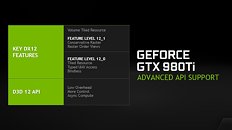- Joined
- Oct 9, 2007
- Messages
- 47,791 (7.40/day)
- Location
- Dublin, Ireland
| System Name | RBMK-1000 |
|---|---|
| Processor | AMD Ryzen 7 5700G |
| Motherboard | Gigabyte B550 AORUS Elite V2 |
| Cooling | DeepCool Gammax L240 V2 |
| Memory | 2x 16GB DDR4-3200 |
| Video Card(s) | Galax RTX 4070 Ti EX |
| Storage | Samsung 990 1TB |
| Display(s) | BenQ 1440p 60 Hz 27-inch |
| Case | Corsair Carbide 100R |
| Audio Device(s) | ASUS SupremeFX S1220A |
| Power Supply | Cooler Master MWE Gold 650W |
| Mouse | ASUS ROG Strix Impact |
| Keyboard | Gamdias Hermes E2 |
| Software | Windows 11 Pro |
AMD's Graphics CoreNext (GCN) architecture does not support Direct3D feature-level 12_1 (DirectX 12.1), according to a ComputerBase.de report. The architecture only supports Direct3D up to feature-level 12_0. Feature-level 12_1 adds three features over 12_0, namely Volume-Tiled Resources, Conservative Rasterization and Rasterizer Ordered Views.
Volume Tiled-resources, is an evolution of tiled-resources (analogous to OpenGL mega-texture), in which the GPU seeks and loads only those portions of a large texture that are relevant to the scene it's rendering, rather than loading the entire texture to the memory. Think of it as a virtual memory system for textures. This greatly reduces video memory usage and bandwidth consumption. Volume tiled-resources is a way of seeking portions of a texture not only along X and Y axes, but adds third dimension. Conservative Rasterization is a means of drawing polygons with additional pixels that make it easier for two polygons to interact with each other in dynamic objects. Raster Ordered Views is a means to optimize raster loads in the order in which they appear in an object. Practical applications include improved shadows.

Given that GCN doesn't feature bare-metal support for D3D feature-level 12_1, its implementation will be as limited as feature-level 11_1 was, when NVIDIA's Kepler didn't support it. This is compounded by the fact that GCN is a more popular GPU architecture than Maxwell (which supports 12_1), thanks to new-generation game consoles. It could explain why NVIDIA dedicated three-fourths of its GeForce GTX 980 Ti press-deck to talking about the features of D3D 12_1 at length. The company probably wants to make a few new effects that rely on D3D 12_1 part of GameWorks, and deflect accusations of exclusivity to the competition (AMD) not supporting certain API features, which are open to them. Granted, AMD GPUs, and modern game consoles such as the Xbox One and PlayStation 4 don't support GameWorks, but that didn't stop big game devs from implementing them.
View at TechPowerUp Main Site
Volume Tiled-resources, is an evolution of tiled-resources (analogous to OpenGL mega-texture), in which the GPU seeks and loads only those portions of a large texture that are relevant to the scene it's rendering, rather than loading the entire texture to the memory. Think of it as a virtual memory system for textures. This greatly reduces video memory usage and bandwidth consumption. Volume tiled-resources is a way of seeking portions of a texture not only along X and Y axes, but adds third dimension. Conservative Rasterization is a means of drawing polygons with additional pixels that make it easier for two polygons to interact with each other in dynamic objects. Raster Ordered Views is a means to optimize raster loads in the order in which they appear in an object. Practical applications include improved shadows.

Given that GCN doesn't feature bare-metal support for D3D feature-level 12_1, its implementation will be as limited as feature-level 11_1 was, when NVIDIA's Kepler didn't support it. This is compounded by the fact that GCN is a more popular GPU architecture than Maxwell (which supports 12_1), thanks to new-generation game consoles. It could explain why NVIDIA dedicated three-fourths of its GeForce GTX 980 Ti press-deck to talking about the features of D3D 12_1 at length. The company probably wants to make a few new effects that rely on D3D 12_1 part of GameWorks, and deflect accusations of exclusivity to the competition (AMD) not supporting certain API features, which are open to them. Granted, AMD GPUs, and modern game consoles such as the Xbox One and PlayStation 4 don't support GameWorks, but that didn't stop big game devs from implementing them.
View at TechPowerUp Main Site






